Description
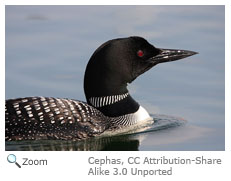 The Common Loon is often identified by its eerie call coming from lakes in the summer. It has a long, flat body with a black head and bill. The Common Loon has a white band around its neck which resembles a collar. Its wings are dark grey speckled with white. The Common Loon is often identified by its eerie call coming from lakes in the summer. It has a long, flat body with a black head and bill. The Common Loon has a white band around its neck which resembles a collar. Its wings are dark grey speckled with white.
Range
The Common Loon has a large range and is migratory. In the summer, it can be found from Alaska to the east coast of the northern United States. In the winter, it can be found throughout the continental United States. The Common Loon spends winters in the waters off of both the east and west coast.
Habitat
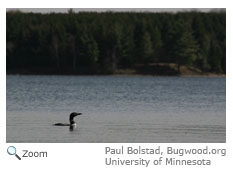 The Common Loon lives on quiet, remote freshwater lakes. In the winter, it is found on lakes, rivers, estuaries and coastlines. The Common Loon is an indicator of water quality because it needs clear water to see swimming fish beneath the surface. The Common Loon breeds in New Hampshire. The Common Loon lives on quiet, remote freshwater lakes. In the winter, it is found on lakes, rivers, estuaries and coastlines. The Common Loon is an indicator of water quality because it needs clear water to see swimming fish beneath the surface. The Common Loon breeds in New Hampshire.
|
|
Diet
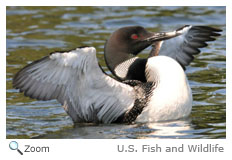 Eating a diet of fish and other aquatic mammals (crayfish, shrimp and leeches), the Common Loon is carnivorous. In addition to fish, some young loons eat insects. The Common Loon is a visual predator, meaning it locates fish by sight and then dives to grab them in their razor sharp bill. To drink, the Common Loon dips its bill into the water and then tilts its head back to swallow. Eating a diet of fish and other aquatic mammals (crayfish, shrimp and leeches), the Common Loon is carnivorous. In addition to fish, some young loons eat insects. The Common Loon is a visual predator, meaning it locates fish by sight and then dives to grab them in their razor sharp bill. To drink, the Common Loon dips its bill into the water and then tilts its head back to swallow.
Life Cycle
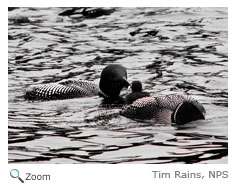 Breeding occurs in the summer. The female and male build a nest out of soil, grass and moss in a sheltered location near deep water. The female typically lays two brown eggs. Both the female and male take turns incubating the eggs for a total of 29 days. Upon hatching, the chicks will stay with their parents for 2 to 3 months. After that time, the chicks are able to fly and become independent from their parents. Breeding occurs in the summer. The female and male build a nest out of soil, grass and moss in a sheltered location near deep water. The female typically lays two brown eggs. Both the female and male take turns incubating the eggs for a total of 29 days. Upon hatching, the chicks will stay with their parents for 2 to 3 months. After that time, the chicks are able to fly and become independent from their parents.
Behavior
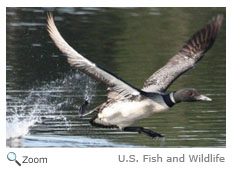 Like airplanes, loons need a runway to take off! The Common Loon needs from 30 yards to a quarter-mile to gain enough speed for lift-off. Because of this requirement, sometimes during migration loons become stranded if they land on a pond too small for take-off. Like airplanes, loons need a runway to take off! The Common Loon needs from 30 yards to a quarter-mile to gain enough speed for lift-off. Because of this requirement, sometimes during migration loons become stranded if they land on a pond too small for take-off. |





